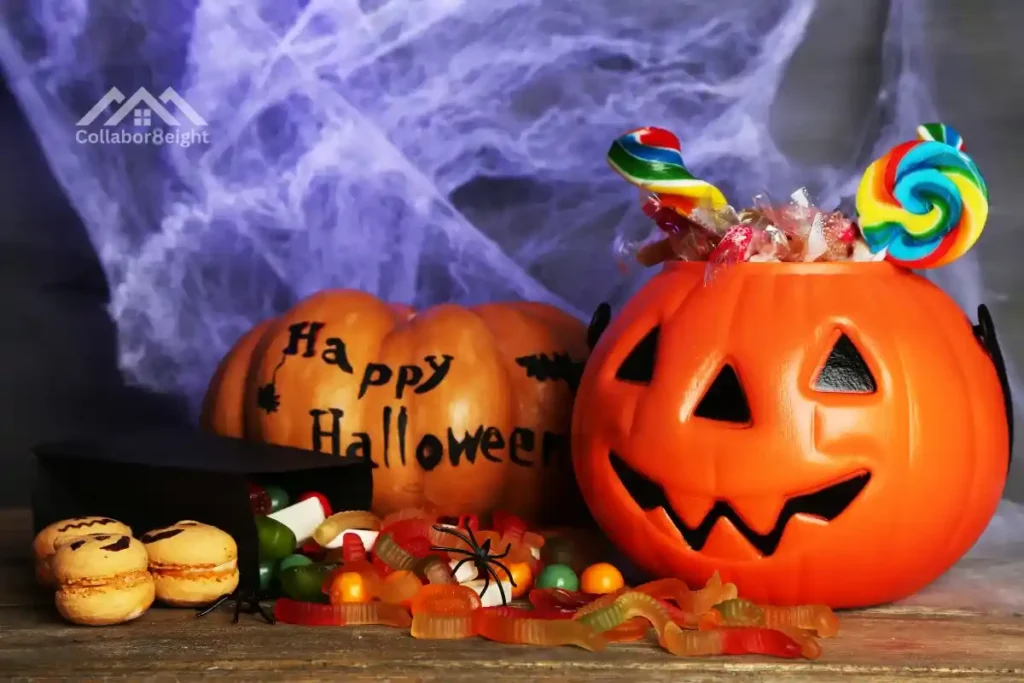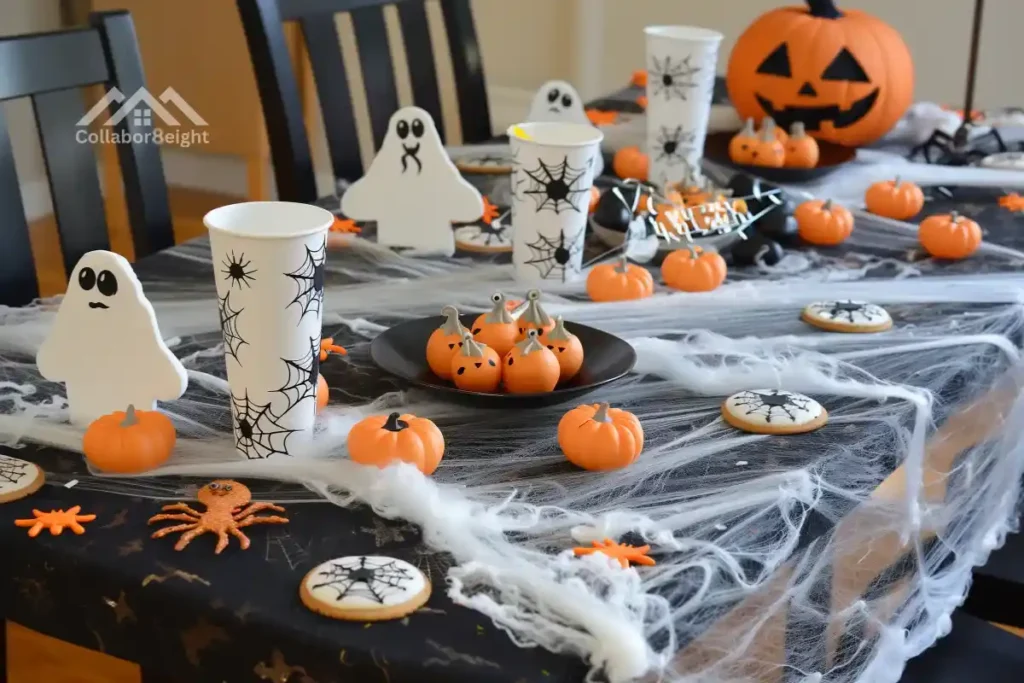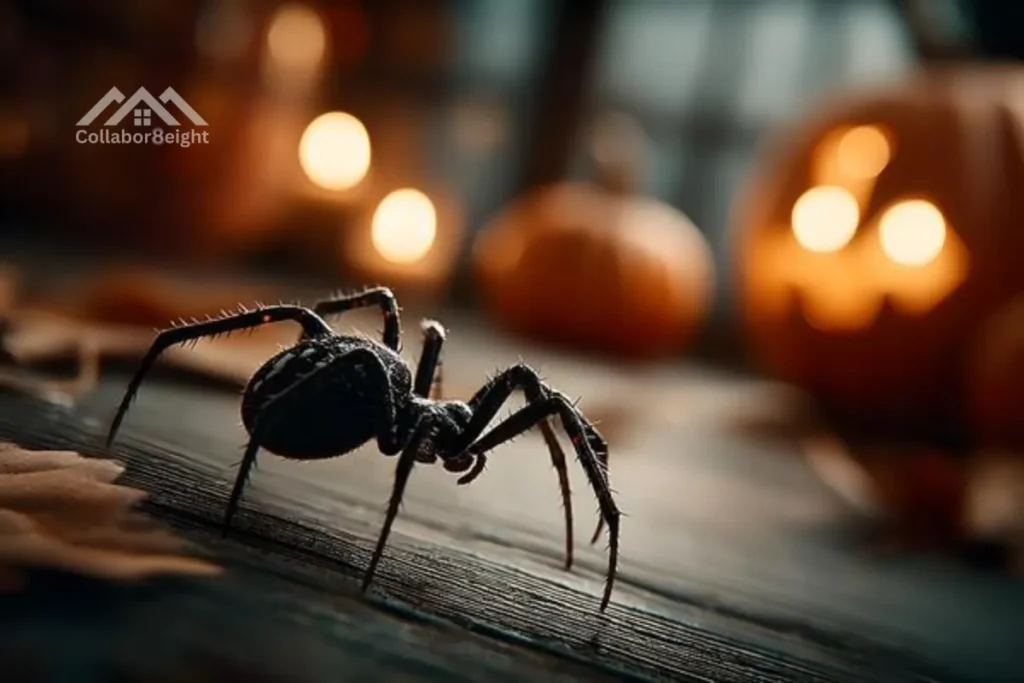Spiders of Halloween: U.S. Species, Myths & Décor Inspiration
Why Spiders Steal the Spotlight on Halloween
When you picture Halloween, what do you see? Pumpkins glowing on porches, kids racing door-to-door in costumes, or maybe cobwebs stretched across front yards with a giant fake spider hanging in the middle? It’s no accident. Spiders are one of the most powerful symbols of the spooky season. Some Halloween spider species are so closely tied to this holiday that spotting one in real life feels like the season has officially arrived.
Spiders & the Spooky Vibe
There’s something about spiders that makes them perfect for Halloween. Their webs look like nature’s decorations, their movements are sneaky & their dark, shadowy shapes add just the right amount of fear. But here’s the fun part—not all spiders are scary! The bright orange pumpkin spider, for example, is completely harmless & even helps by catching pesky insects.
Why You See More Spiders in October
Ever notice that spiders seem to appear everywhere in the fall? That’s because October is when many grow to their full size, making them easier to spot. It’s also when they spin bigger webs in gardens, porches & sometimes right across your walkway. Cooler weather may even drive them indoors. For many people, it feels like they just magically appear right when Halloween decorations go up, adding to the mystery of the season.
The Scary Side of Halloween Spider Species
Of course, not all spiders are harmless. In the U.S., black widows & brown recluses are two of the most talked-about Halloween spider species because of their venomous bites. The good news? These spiders aren’t out to get you. Most prefer to hide away & only bite when they feel trapped or threatened. Even the big, hairy wolf spiders that give people chills are more focused on hunting bugs than haunting humans.
Spiders as the Symbol of Halloween
Spiders & their webs are everywhere in October—on costumes, in haunted houses & across front yards. They’ve become a lasting symbol of fear, mystery & fascination. Whether you find them creepy, cool, or a mix of both, it’s clear that spiders have earned their spot as one of Halloween’s most unforgettable icons.
Iconic Halloween Spiders in the U.S.
Spiders aren’t just decorations—they’re real creatures that pop up every fall & add to the spooky vibe. Some of the most famous Halloween spider species are common across the United States, each with its own look, legend & level of scariness. Let’s meet them!
The Pumpkin Spider (Araneus marmoreus)
This bright orange spider is nicknamed the “pumpkin spider,” & for good reason—it looks just like a tiny Halloween pumpkin! You’ll spot it hanging in gardens or wooded areas, spinning huge round webs. Don’t worry, though—it’s harmless & won’t bite unless it’s scared.
The Black Widow (Latrodectus mactans)
When people talk about dangerous Halloween spider species, the black widow is usually the first that comes to mind. With its shiny black body & red hourglass mark, it’s one of the most recognizable spiders in America. Its bite can be serious, but black widows prefer to stay hidden & avoid people.
The Brown Recluse (Loxosceles reclusa)
The brown recluse is another spider that often gets a spooky reputation. Found mostly in the central & southern U.S., it has a small violin-shaped marking on its back. While its bite can cause medical issues, it’s actually very shy & rarely comes out unless disturbed.
The Yellow Garden Spider (Argiope aurantia)
This large black-and-yellow beauty is often called the “writing spider” because of the zig-zag patterns it makes in its web. These spiders are most active in late summer & fall, so you’ll often see them right around Halloween. Despite their size, they’re completely harmless to humans.
Wolf Spiders
If you’ve ever seen a big, hairy spider dart across the floor, chances are it was a wolf spider. They look scary, especially at night, but they aren’t dangerous. In fact, wolf spiders are helpful hunters that keep your home free of other bugs.
Common House Spiders
These little spiders are often mistaken for more dangerous Halloween spider species, but they’re totally harmless. They love building webs in quiet corners, basements, or attics, which makes them one of the most common “spooky sightings” in October.
The Science Behind Halloween Spider Sightings
Spiders don’t just show up in October because they like the spooky season. There’s actually a scientific reason why so many people notice more Halloween spider species around this time of year. Let’s break it down in a simple way.

Bigger Spiders in Fall
By the time autumn arrives, many spiders have reached their full adult size. That’s why they suddenly look larger, scarier & more noticeable. They’ve been around all summer, but in October, they’re finally big enough to stand out in your garden, porch, or basement.
Webs That Appear Overnight
Fall is the prime web-building season. Female orb weavers, for example, create massive circular webs that shine with morning dew. These webs are so big that you might walk right into one by accident—something that feels especially creepy around Halloween! For many people, these giant webs are the reason spiders seem so tied to the holiday.
Mating Season Mystery
Another reason you may see more spiders in the fall? It’s mating season. Male spiders wander in search of females, which explains why they sometimes appear inside homes. While it can feel alarming to spot one crawling across the floor, it’s usually just a confused traveler, not a monster on a mission.
Spiders Moving Indoors
When the weather cools, spiders look for warmth & shelter. That’s why basements, garages, & attics become popular hideouts. Contrary to common belief, spiders don’t invade homes to “attack” people—they’re simply following instincts to survive the colder nights.
Why They Feel So “Halloween”
All of these natural behaviors—bigger bodies, giant webs, surprise indoor visits—line up perfectly with Halloween season. It’s no wonder people associate them with ghosts, witches & spooky decorations. Real-life Halloween spider species like the pumpkin spider, black widow & wolf spider only add to the eerie atmosphere.
Helpful, Not Harmful
While spiders may look creepy, most are harmless & even helpful. They eat mosquitoes, flies & other pests that truly bother humans. So the next time you spot a spider this fall, remember—it’s just doing its job, not trying to star in your haunted house.
How to Identify U.S. Spiders at Halloween
With so many Halloween spider species crawling around during October, it helps to know which ones you’re actually looking at. While some are totally harmless, others—like the black widow or brown recluse—deserve a little more caution. The good news? With a few simple tips, you can tell the difference without becoming an expert.
Look at the Color & Markings
- Pumpkin Spider – Bright orange with patterns that make it look like a tiny Halloween pumpkin.
- Black Widow – Shiny black body with a red hourglass shape on the underside of the abdomen.
- Brown Recluse – Brown body with a violin-shaped marking on the back.
- Yellow Garden Spider – Black & yellow stripes, often found in webs outdoors.
- Wolf Spiders – Brown or gray, hairy & larger than most house spiders.
Colors & unique markings are one of the easiest ways to identify spiders, especially during the fall.
Check the Web Type
Different spiders build different webs & this can help you figure out what you’re dealing with.
- Orb Weavers – Large, round, wheel-shaped webs (often seen in gardens).
- Cobweb Spiders – Messy, irregular webs, common in corners of homes.
- Funnel Weavers – Flat webs with a tunnel where the spider hides.
If you spot a huge, round web shining in the morning dew, chances are it belongs to a harmless orb weaver, one of the most common Halloween spider species seen outdoors.
Pay Attention to Size & Shape
While some spiders look terrifying because of their size, size alone doesn’t mean danger.
- Black widows are small (about the size of a paperclip) but venomous.
- Wolf spiders are big & hairy, yet harmless.
- Pumpkin spiders grow round & plump in fall, making them look scarier than they really are.
Location Matters
Where you find the spider can also give you clues.
- Outdoors in webs → likely an orb weaver or garden spider.
- Hiding in dark corners → could be a house spider.
- Basement or closet → in some U.S. regions, possibly a brown recluse.
A Friendly Reminder
Most Halloween spider species in the U.S. are safe to be around & even helpful for controlling pests. Spotting them may feel spooky, but it’s usually just another sign that fall & Halloween—has truly arrived.
Spider Myths & Folklore in American Halloween
Spiders have been a part of spooky stories for centuries, long before they became plastic decorations in party stores. In American culture, they’re tied to witches, haunted houses & ghost stories. But why do these creepy crawlers have such a strong connection to Halloween? The answer lies in myths, folklore & centuries of superstition surrounding Halloween spider species.
Spiders & Witches
In old European folklore, spiders were often seen as companions to witches. People believed that if you saw a spider on Halloween night, it might be the spirit of a loved one keeping watch. This legend traveled to America & became part of the Halloween tradition. Today, spider webs on haunted houses & witch costumes keep that spooky connection alive.
The Web as a Symbol of Mystery
Spider webs are more than just sticky traps—they’re symbols of patience, secrets & the unseen. In Halloween stories, webs are often linked to hidden dangers or creepy corners you don’t want to enter. That’s why Halloween decorations almost always include fake cobwebs. They instantly create an eerie feeling, as if something mysterious is waiting in the shadows.
Myths About Spider Danger
Many people believe that most Halloween spider species are deadly, but that’s not true. Out of the thousands of spider species in the U.S., only a few (like the black widow & brown recluse) pose real medical risks. The rest are harmless & even helpful. Still, the myth that “all spiders are dangerous” keeps them in the spotlight as one of Halloween’s scariest symbols.
Spiders in Pop Culture
Movies, books & TV shows have also given spiders a starring role in spooky entertainment. From giant spider monsters in horror films to the cobweb-filled lairs in haunted houses, spiders have become a shorthand for fear. This cultural reinforcement has helped make them an inseparable part of Halloween celebrations.
Why They Stay Spooky
The combination of real-life encounters, old folklore & pop culture has kept spiders in their role as Halloween icons. Whether you see them as magical, creepy, or misunderstood, Halloween spider species will always crawl their way into stories & decorations during the spookiest time of year.
Spiders as Natural Halloween Decor
When it comes to Halloween decorations, nothing sets the scene like a creepy cobweb with a spider waiting in the middle. But did you know that some real Halloween spider species are already decorating your yard & garden for free? Their webs, colors & shapes make them look like they were designed for a spooky season.

Nature’s Own Decorations
- Orb Weavers – These spiders spin massive circular webs that glisten with dew in the morning. They look like something straight out of a haunted forest.
- Pumpkin Spiders – With their round, orange bodies, they add a natural Halloween “pumpkin touch” to gardens.
- Yellow Garden Spiders – Their bright colors & zig-zag web patterns look like artwork created just for the season.
Instead of buying fake cobwebs, many homeowners discover that nature has already done the decorating!
Safe Spooky Inspiration
The beauty of using real spiders as Halloween inspiration is that they’re completely authentic. A web hanging in the corner of your porch instantly gives off a spooky vibe without any effort. Of course, if you don’t want to leave a real spider in place, you can use them as inspiration for DIY crafts—like yarn webs, paper spider cutouts, or orange-and-black centerpieces.
The Role of Color
Orange, black & yellow are the main colors of Halloween. Interestingly, many Halloween spider species show off these very shades. That’s part of why people link them so closely with the holiday. When you spot an orange pumpkin spider in October, it feels like nature has joined in on the celebration.
A Spooky but Helpful Friend
Here’s the part most people forget: while spiders add an eerie look to Halloween, they’re also hard-working pest controllers. That pumpkin spider in your garden? It’s catching flies. That wolf spider hiding in your basement? It’s hunting other bugs. Even though they look creepy, spiders are quietly helping you out during the season.
From Creepy to Creative
Whether you leave real webs in place for effect or copy their patterns in decorations, spiders are a perfect symbol of Halloween. They blur the line between scary & fascinating, making them the ultimate natural accessory for the spooky season.
Safety First: Venom & Bites
Spiders may look scary, but most of them are harmless. Out of the thousands of species in the U.S., only a small handful can cause real medical problems. Still, because some Halloween spider species are linked with venomous bites, it’s worth knowing the facts.
The Black Widow
The black widow is one of the most infamous spiders in America. Its shiny black body & red hourglass mark make it easy to recognize. A bite from a black widow can cause muscle cramps, nausea & pain, but deaths are extremely rare. These spiders prefer to hide in quiet, undisturbed spots like woodpiles or sheds & usually bite only if threatened.
The Brown Recluse
The brown recluse is another Halloween spider species that gets a lot of attention. Found mostly in the central & southern U.S., it has a violin-shaped marking on its back. Its bite can sometimes lead to skin irritation or sores. However, just like the black widow, this spider is shy & avoids humans whenever possible.
Harmless but Spooky Spiders
Most of the spiders people see around Halloween—like pumpkin spiders, wolf spiders & yellow garden spiders—are not dangerous. They may look big, hairy, or colorful, but their bites are either harmless or no worse than a mosquito bite. In fact, these spiders are more interested in catching insects than bothering people.
What to Do If You’re Bitten
- Stay calm. Most bites are harmless.
- Clean the area. Wash with soap & water.
- Apply ice. Helps reduce swelling.
- Seek medical help if you suspect it’s from a black widow or brown recluse, or if symptoms worsen.
Myths vs Reality
One of the biggest myths is that spiders “attack” people. In truth, they don’t go looking for humans. Most bites happen by accident—like when someone puts on a shoe or moves a box where a spider was hiding.
The Bottom Line
While a few Halloween spider species have venom strong enough to cause problems, the vast majority are harmless helpers. Knowing the difference between dangerous & safe species makes it easier to enjoy the spooky season without unnecessary fear.
Final Thought
Spiders may look creepy, but they’re one of the most fascinating parts of Halloween. From the mysterious black widow to the harmless pumpkin spider, each of these Halloween spider species adds its own touch of magic to the season. Some are spooky, some are colorful & many are surprisingly helpful.
So the next time you see a web glistening on your porch or a spider crawling across your yard in October, don’t just think “scary”—think of it as nature’s way of decorating for Halloween.
FAQs About Halloween Spider Species
1. What are Halloween spider species?
They are spider types often linked to Halloween because of their spooky looks, colors, or famous reputations. Examples include black widows, pumpkin spiders, wolf spiders & orb weavers.
2. Are Halloween spider species dangerous?
Most of them are not harmful. While black widows & brown recluses have venomous bites, species like pumpkin spiders, orb weavers & wolf spiders are harmless & actually helpful in controlling pests.
3. Why are spiders connected to Halloween?
Spiders symbolize mystery, darkness & fear, which fit the spooky mood of Halloween. Their webs, creepy movements & colors (black, orange & yellow) make them a natural part of Halloween themes.
4. Can I use real spiders for Halloween decor?
Yes, some people let Halloween spider species like orb weavers decorate naturally with their webs. But if you don’t want real ones around, you can use them as inspiration for DIY crafts or store-bought decorations.
5. How can I tell if a spider is poisonous?
Dangerous spiders like the black widow have clear markings (red hourglass) & the brown recluse has a violin-shaped mark. Most other spiders you see in your garden or home during Halloween are harmless.
6. Do spiders bite people on purpose?
No, spiders don’t hunt humans. They bite only when they feel trapped or threatened, like if someone accidentally touches them in a shoe, blanket, or storage box.
7. Which Halloween spider species are best for kids to learn about?
Pumpkin spiders & orb weavers are great choices—they look spooky but are completely harmless. Learning about them can make kids appreciate nature instead of being scared.





